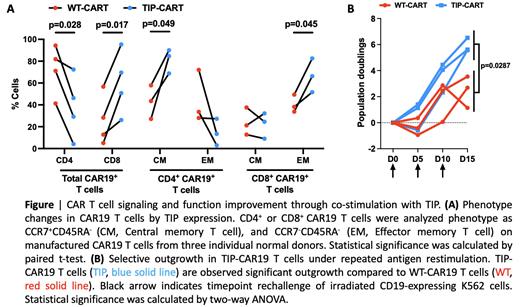Adoptive cell therapy using Chimeric Antigen Receptor (CAR) T cells, such as Tisagenlecleucel and Axicabtagene Ciloleucel, has revolutionized cancer immunotherapy and become a game-changer in cancer care. However, several challenges, including durable remission and limited expansion after infusion, persist. Recent work from the Riddell lab (PMID: 34429382) demonstrated that T Cell Receptors (TCRs) are more sensitive than CARs due to the presence of T cell signaling proteins like CD3-, CD3ε, and CD3-, which facilitate the recruitment of Lck to phosphorylate immunoreceptor tyrosine-based activation motifs (ITAMs). Although CARs were designed to mimic TCR signaling, they still lack the full sensitivity.
In this study, we hypothesized that enhancing tyrosine phosphorylation of the immunoreceptor tyrosine-based activation motifs (ITAMs) presented on CD3 in CAR T cells amplifies the CAR-mediated signaling as well as improves sensitivity of CAR co-stimulatory signaling. To achieve this, we developed a novel co-stimulation system where anti-CD19 CAR T cells co-expressed Tip37, a 37-amino acid segment of the Herpesvirus saimiri (HVS) tyrosine-protein kinase-interacting protein (Tip). This specific segment interacts exclusively with the major T cell kinase, Lck, effectively regulating its kinase activation. The critical region for this interaction lies within 37 amino acids (146-182) in the central part of Tip, which contains two motifs: the SH3 binding motif (SH3B; 174-182) and the C-terminal Src-related kinase homology motif (CSKH; 146-155). The 37 amino acid peptide fragments alone form a stable complex with Lck. Lck is crucial in the initial stages of T cell activation, not only when triggered by the native TCR stimulation but also in response to CAR-antigen stimulation. Following antigen-induced T cell activation, Lck initiates the phosphorylation of tyrosines in the ITAMs present in CD3ζ domains. This leads to the recruitment of ZAP70 kinases to the ITAMs of CD3ζ, facilitating the formation of signaling protein complexes. The results of our in vitro experiments using the immortalized T cell line, Jurkat cells, demonstrate that the inclusion of the Tip37 component in the CAR leads to the formation of the Lck-CAR complex. This, in turn, significantly enhances the phosphorylation of ITAMs in CARs and triggers downstream signaling. Importantly, the CAR T cells with the Tip37 co-stimulatory domain do not secrete cytokines when in an unstimulated state. This suggests that the heightened Lck phosphorylation does not lead to the auto-activation of T cells. As a result, CAR T cells engineered with Tip37 can be considered safe and hold promise for future applications.
We engineered CAR19 T cells co-expressing Tip (Tip-CART19 cells) with a co-stimulatory domain of 4-1BB and CD3 (Tip-CART19 cells). As a control, we generated CART19 cells lacking the TIP domain (WT CART19 cells). We confirmed that Tip expression induced enhanced CD3 phosphorylation in CART19 T cells. Additionally, we observed that a significantly augmented outgrowth of CD8+ cells engineered with the TIP-containing CAR compared with canonical CAR T cells. Further, TIP-CAR T cells displayed increased expression of CD38 and Ki67. Interestingly, we also noted an expansion of CCR7+CD45RA- central memory subsets in CD4+ CART19 cells and CCR7-CD45RA- effector memory subsets in CD8+ CART19 cells. Finally, as evidenced by apparent changes in phenotype, Tip-CART19 cells exhibited improved cytotoxic ability and significant outgrowth of CART19 cells with in vitro repeated CAR stimulation using CD19-expressing tumor cells, as previously described in our study (Fraietta et al., Nature 2018).
This study highlights that amplification of the constitutive Lck recruitment and amplified CD3 phosphorylation in CART19 cells via the introduction of Tip37 domain results in enhanced anti-leukemia cytotoxic ability and preservation of proliferative function in CART19 cells. Our discovery introduces a novel approach for amplifying CAR signaling to improve CAR T cell therapy.
Disclosures
No relevant conflicts of interest to declare.


